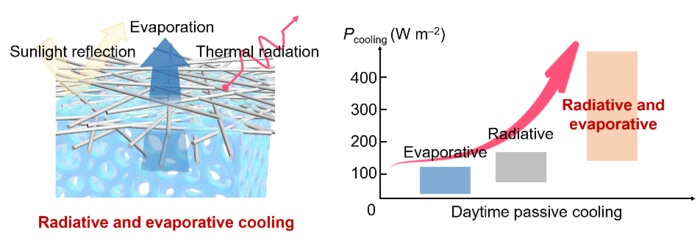Large-scale, effective, and passive: these descriptions are aptly given to the integrated radiative and evaporative chiller (IREC), designed and tested by researchers at Tsinghua University in Beijing, China. The goal of this technology is to come up with an energetically affordable method of cooling to aid in the rising consumption of energy while still minimizing carbon emissions through the process.
“Energy scarcity is a universal challenge to global development. The demand for cooling has accounted for more than 10% of the total global electricity consumption, and the trend is increasing year by year” said Liangti Qu, author of the paper and researcher at Tsinghua University.
In efforts to find a solution to a rising energy challenge, researchers worked to develop IREC. IREC works in tandem with a couple of partners, which include a polyacrylamide hydrogel layer and breathable, reflective fibers on the surface to reflect light. The hydrogel layer aids in speeding up the evaporation process as well as keeping the energy input from the sun minimized. The reflective fibers can keep the energy from solar radiation from heating the water and are shown to be effective against high angles of light, making it effective during all parts of the day in all regions of the world.
The report was published in Nano Research Energy on March 09.
During their study, the researchers found that IREC can reduce the heat inside outdoor storage items by more than 9 ºC, making it an appealing option for outdoor cooling options.
“This technology can achieve cooling powers of over 700 W m–2, several times that of a single radiative cooling process. Besides, the working mode is compatible with the existing central heating equipment and can be used for central cooling in summer by supplying cold water. It promises to be a sustainable alternative to current cooling needs” Qu said.
Additionally, it was shown that up to 69.2% of the heat consumed by IREC came from the environment. The IREC technology absorbs heat from the environment, thereby cooling it through evaporation. As if the technology wasn’t appealing enough in its efforts to be sustainable and cost-effective, the ability to set the IREC up on existing central heating equipment reduces the barrier to entry for those wishing for a more sustainable, energy-efficient cooling method.
The experiment also ran multiple tests to determine how well the radiative and evaporative cooling technique works under various conditions, such as indoor and outdoor use, and even use on the human body to aid in cooling.
On human skin, IREC mimics the sweat reaction humans have to keep cool under hot conditions and can assist in cooling the body by 13º C for over 12 hours. The wide application of this technology for not only commercial use but also personal use makes it even more appealing to researchers to continue to develop and streamline the process for wide-scale production.
Finding methods of cooling that are both cost and energy efficient will continue to be a challenge, especially to make them affordable and available on a large scale. Ideally, once the prototype is streamlined and optimized, the researchers want to see this integrated cooling technology commercially available for use in “green” buildings and industrial storage facilities.
Houze Yao, Huhu Cheng, Qihua Liao, Xuanzhang Hao, Kaixuan Zhu, Yaje Hu, and Liangti Qu from the Department of Mechanical Engineering and Department of Chemistry at Tsinghua University contributed to this research.
The National Natural Science Foundation of China, State Key Laboratory of Tribology, Tsinghua-Foshan Innovation Special Fund, and a grant from the Institute for Guo Qiang at Tsinghua University made this research possible through financial support.

